Tips on using a DeWalt Demolition Hammer
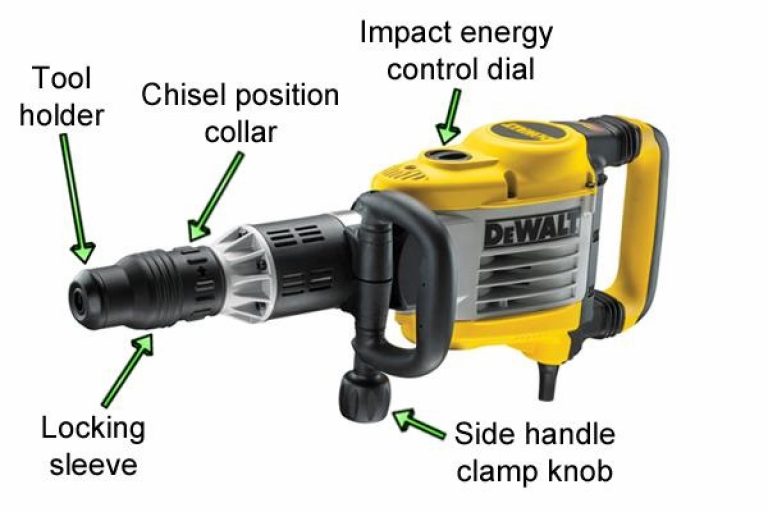
At Wonkee Donkee, we believe that before you use any power tools it is vitally important that you read and understand all of the functions and safety advice. Our number one tip is to always be safe when using any power tools and that includes wearing the appropriate personal protective equipment for the task!
Inserting and Removing Chisel Bits
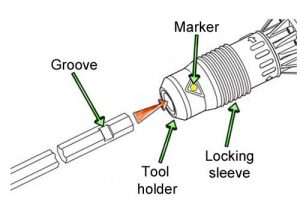
Clean (but don’t lubricate) the shank of the chisel and pull back the locking sleeve. Line up the groove with the marker then push the shank of the chisel into the tool holder and let go of the locking sleeve.
Pull on the chisel to make sure it’s secure. It should be able to move a few centimetres to enable the hammer function to work, but not come loose.
To remove the chisel, retract the locking sleeve and pull the chisel out of the tool holder.
Setting Chisel Position
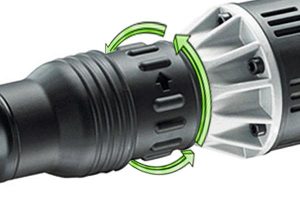
For ease of use you will find that you are able to set, or index, the chisel into one of 12 different positions.
After inserting the attachment, turn the chisel position collar anti-clockwise, in the direction of the arrow, until it’s in the right place for your task.
Setting Electronic Impact Control Dial
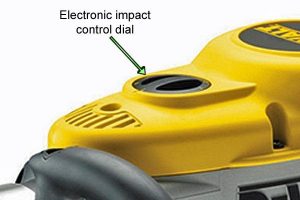
This feature is available on some upper range DeWalt SDS-Max demolition hammers and makes them very versatile, as you can adjust the power to suit the task. The settings range from 1 (low) to 7 (full power), and you simply turn the dial up or down to increase or reduce the impact energy.
A high setting is best for breaking harder materials such as stone or concrete; a low setting is more suitable for chiseling soft or brittle materials, or when you’re trying to avoid breakout.
Adjusting Side Handle

For ease of use you can mount the side handle on the right or left side of the machine.
Unscrew the side handle clamp knob then slide the handle on to the tool until the steel ring is sitting in the mounting area. The handle should be positioned between the head and centre of the tube.
Adjust the side handle to the angle you need, then slide and rotate it to your preferred position. Tighten the clamp knob to lock the handle in place.
Switching On and Off

The demolition hammer will run in continuous operation when turned on. The on/off rocker switch can be found just under the main handle, although its size and exact position may vary slightly according to model.
Make sure you know the location of any electrical wiring along with water and gas pipes before you switch on the tool.
And keep the power cable behind you, well away from the chisel.
Making the most of Active Vibration Control
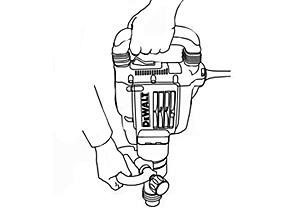
This feature reduces rebound vibration from the hammer action, which makes the machine more comfortable to use and extends tool life.
For maximum safety and control, hold the demolition hammer with one hand on the main handle and the other on the side handle.
Apply firm pressure, but don’t lean too hard on the machine – this won’t speed up the chiseling process but will merely worsen performance and shorten the life of the tool.
Tips on Chiseling
Which Bit?
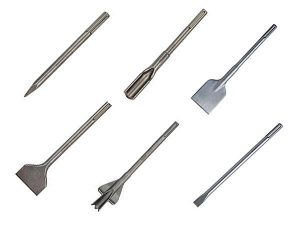
Choosing the right bit can make all the difference to the speed and effectiveness of your demolition hammer.
Small bits are best for tight spaces, while pointed ones will help you split rocks easily. Broad pointed bits are ideal for whole walls or large expanses of flooring, and chisel bits are suitable for carving channels into concrete for wiring and pipework.
Hold Tight
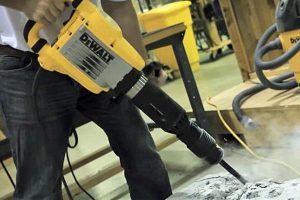
Keep a good grip and press the demolition hammer firmly into the surface you’re trying to remove. If you hold the machine too lightly it may slip, which could be dangerous.
Don’t point the tool straight down, as it will simply make a hole in one spot. Hold it with the chisel at approximately a 90° angle to the surface, so the tip can chip into, rather than right through, the material.
Get Going

Start off making short chiselling strikes of around 10 or 20 seconds, then change the angle.
When you’re demolishing a wall, it’s best to start as close to the centre as possible and chisel downwards. The weight from the load at the top should make the wall collapse on its own.
When working on a floor it makes sense to start at one of the edges, rather than the middle, so you can easily remove debris as you go along.
Keep Your Cool

Every now and then, lift the bit off the surface you’re working on and let the demolition hammer run with no load for a few seconds. The cool air will help prevent it from overheating.
Don’t touch the bit or tool holder immediately after use – they can become extremely hot, and you are likely to get burnt.
Take It Easy

Even with the latest technological advances, vibration from the powerful piston action makes any demolition hammer unsuitable for extended periods of use, so take frequent breaks.
Wear thick gloves for extra padding, and don’t forget ear defenders and safety glasses or goggles.
Look Sharp
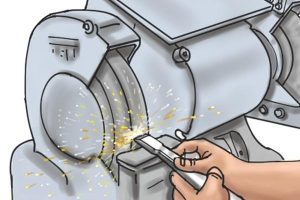
Keep your chisels sharpened and in good condition to achieve the best results. Worn chisels can also be dangerous if fragments fly off. However, be aware that you can only regrind them a limited number of times before they will need replacing.
For tips on sharpening tools see How to use a DeWalt Bench Grinder?






